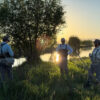
Idaho Department of Parks and Recreation
PO Box 83720. Boise, ID 83720-0065. 208-514-2254. Fax: 208-334-3741
NEWS RELEASE
FOR IMMEDIATE RELEASE
Date: January 17, 2012
AVALANCHE DANGER IS LIKELY TO INCREASE IN MANY IDAHO LOCATIONS – IDPR URGES RECREATORS TO USE CAUTION
IDAHO (January 17, 2012) – Avalanche danger has been moderate to considerable in many Idaho locations with the little snowpack that currently exists. The Idaho Department of Parks and Recreation (IDPR) urges snowmobilers and backcountry skiers to use caution as they head out to play. Incoming precipitation will likely increase the instability that currently exists by adding additional stress to a faceted snow base.
“Anyone heading outdoors to recreate in the fresh snow needs to take special precaution,” said Rich Gummersall, Outdoor Education Coordinator for IDPR. “What exists out there currently is a base layer with no bonding properties with an ice layer sitting on top due to warming and rain showers. The incoming precipitation will add additional weight which will increase the stress on the snow pack. The fresh snow will be deceiving and the perfect composition for avalanches.”
IDPR encourages you to:
* Know the capabilities of yourself and your equipment.
* Familiarize yourself with terrain, snow and weather conditions.
* Carry proper rescue gear and know how to use it.
* Take an avalanche awareness course.
* Visit avalanche.org for current forecasts.
The Idaho Department of Parks and Recreation (IDPR) offers free snowmobile-centered avalanche awareness courses throughout the state. Avalanche awareness training provides snowmobile riders with the information needed to make informed decisions.
Visit www.parksandrecreation.idaho.gov for additional information on IDPR sponsored avalanche classes and to locate a course taking place near you.
Snowmobile-Centered Avalanche Facts follow:
Idaho Department of Parks and Recreation
AVALANCHE AWARENESS FOR SNOWMOBILERS
HOW CAN BACKCOUNTRY USERS RECOGNIZE AVALANCHE TERRAIN?
Most large avalanche paths are obvious: an open slope, bowl, or gully above timberline that leads to a swath through the trees. But small avalanche paths in the trees can be just as dangerous. Slope angle is the most important factor, so you should carry a slope meter. You also need to observe snow deposition patterns and the effects of anchors such as rocks or trees that might prevent avalanches on some slopes. Finally, bent or damaged trees are good clues that show where avalanches have run in the past.
WHAT CAN YOU DO TO AVOID BEING CAUGHT IN AVALANCHE TERRAIN?
o Avoid avalanche terrain all together.
o Learn about avalanches to minimize your risk. Take a class!
o Roll the dice and play for the best.
WHERE CAN YOU RECEIVE AVALANCHE TRAINING?
o Idaho Department of Parks and Recreation
o Sawtooth Avalanche Center
o Payette Avalanche Center
o Panhandle Avalanche Center
AVALANCHES ONLY HAPPEN WHEN – A SLOPE IS STEEP ENOUGH = SLOPE ANGLE
(Generally slab avalanches can occur between 25 and 60 degrees, but most slab avalanches occur with starting zones between 30 and 45 degrees. Above 60 degrees and the snow sluffs, below 25 degrees and the stresses on the pack from gravity typically aren’t great enough to cause the snow to slide.)
AVALANCHES ONLY HAPPEN WHEN –
* SNOW CONDITIONS ARE UNSTABLE (When the snow cover is very unstable, nature often broadcasts clear danger signals. Fresh avalanches are the best clue. Snow that cracks, collapses, or makes hollow sounds is also unstable. Weak layers that are found by digging snow pits are signs of unstable snow. Snow that has become wet from thaw or rain can be dangerous. Even if you find no signs of unstable snow, you should always travel using the techniques listed above for minimizing risk.)
* THERE IS A TRIGGER (A trigger can be human, animal or weather. Of course when it is human that most directly affects us, so we as recreationists need to ready, willing and able to make safe travel decisions.)
WHAT IS SAFE TRAVEL? (In order to made objective assessments you need some information about the snow. The conditions in the backcountry can change daily, even hourly, and avalanche centers provide you with recent snowpack stability information. You’ll still need to make your own assessment for any given slope, but avalanche centers can provide you with information about previous snow and wind events, buried weak layers and general concerns that you can focus on. So, be sure to visit www.avalanche.org.)
WHAT HAPPENS WHEN SAFE TRAVEL FAILS? (Every snowmobiler and backcountry recreationists should carry a pack with three days emergency supplies, a probe, a shovel and an avalanche transceiver (beacon). Most importantly they should be comfortable using their rescue gear.)
HOW CAN YOU KEEP FROM GETTING CAUGHT IN AN AVALANCHE?
You can reliably avoid avalanches by recognizing and avoiding avalanche terrain. Travel at the valley floor away from large avalanche run outs, along ridge tops above avalanche paths, in dense timber, or on slopes of 25 degrees or less that do not have steeper slopes above them. Avoid cornices on ridge tops.
You cannot entirely eliminate risk if you travel in avalanche terrain, but you can minimize risk by using good technique, such as: climb, descend, or cross avalanche areas ONE AT A TIME; cross a slope at the very top or bottom if possible; climb or descend the edge of a slope rather than the center; carry and know how to use avalanche rescue gear; and turn back or alter your route if you detect signs of unstable snow.
AVALANCHE HISTORY –
o Last 5 years in Idaho there were 13 avalanche incidents 11 of which were snowmobilers.
o Last 5 years nationwide – 83 snowmobile fatalities and 39 skiers.
AVALANCHE STATISTICS –
o 85% of avalanche victims will survive if recovered within 15 minutes.
o 25% of avalanche victims die of trauma incurred during slide.
WHAT CAN YOU DO IF YOU ARE CAUGHT IN AN AVALANCHE?
Surviving avalanches can depend on luck; therefore, it is always better to avoid them in the first place. Remember that only 1 of 3 victims buried without a beacon survives. If you are caught, first try to escape to the side, or grab a tree or rock. Swim with the avalanche to try to stay on top and avoid trees. When the avalanche slows down, reach the surface or make an air pocket.
WHAT CAUSES AN AVALANCHE?
An avalanche occurs when the stress (from gravity) trying to pull the snow downhill exceeds the strength (from bonds between snow grains) of the snow cover.
There are three ingredients of an avalanche:
1. A steep slope (About 90% of all avalanches start on slopes of 30-45 degrees.)
2. An unstable snow pack (Fresh avalanches are the best clue. Snow that cracks, collapses, or makes hollow sounds is also unstable.)
3. A trigger (Human triggers, Animal Triggers or Weather triggers)
The recipe for a slab avalanche:
1. Cohesive mass of snow
2. Weak layer
3. Steep slope
4. Trigger
WHEN ARE AVALANCHES MOST LIKELY TO OCCUR?
The avalanche danger increases with major snowstorms and periods of thaw. About 2,300 avalanches are reported to the Avalanche Center in an average winter. More than 80% of these fall during or just after large snowstorms. The most avalanche-prone months are, in order, February, March, and January. Avalanches caused by thaw occur most often in April.
WHERE DO AVALANCHES OCCUR?
Almost all avalanches occur on slopes between 35 and 45 degrees. Slopes less than 30 degrees seldom produce avalanches and slopes steeper than about 50 degrees sluff so often that they tend not to build up into slabs. So it’s the intermediate slope steepness that produces most of the avalanches. But the bad news is that exactly the kind of slopes we like to ski, snowboard or snowmobile usually produces most of the avalanches. A black diamond slope at a ski resort is usually around 35 degrees–prime steepness for avalanche danger.



